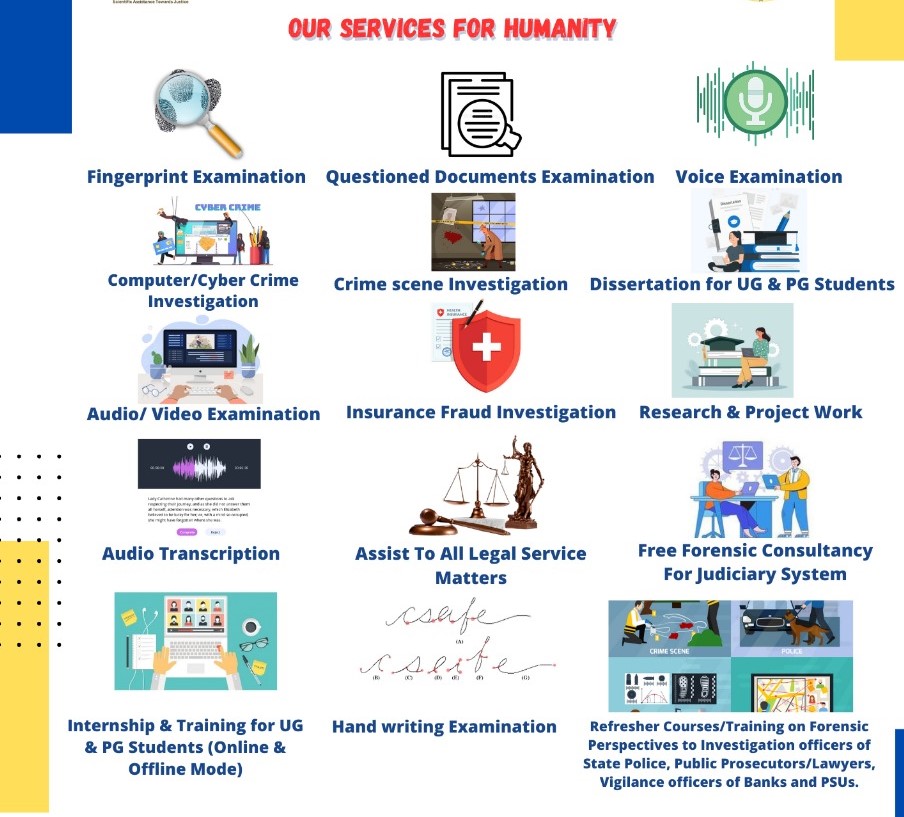Definition of Digital
Forensics Digital forensics is the process of identifying, collecting, analyzing, and preserving digital evidence from electronic devices to investigate cyber incidents, criminal activities, or legal disputes. It plays a crucial role in uncovering facts and establishing a timeline of events related to a cyberattack or security breach. Digital Forensics is a part of the Forensic Science discipline.
Definition of Cybersecurity
Cybersecurity is the practice of protecting systems, networks, devices, and data from digital attacks, unauthorized access, and damage. Its primary goal is to ensure the confidentiality, integrity, and availability which is in short referred to as the C-I-A of information and resources in the digital environment. Cybersecurity is mainly a discipline coming under Software Engineering field. Now let us take a look at some examples and case studies on both Digital Forensics and Cybersecurity[1]-
1.The Equifax Breach
One of the biggest data breaches globally is the massive data breach was in 2017 where hackers exploited the website of Equifax, a multinational consumer credit reporting agency. This incident was particularly disruptive and resulted in the loss of data of about 147 million customers worldwide. This massive data breach was possible because of Equifax’s blunder in not identifying and patching vulnerabilities website Apache struts, causing the compromise of personal details and IDs to hackers responsible.
2.WannaCry Ransomware
One of the most notorious cyberattack was the WannaCry ransomware attack that caused massive destruction and chaos. It infected Windows computers worldwide and impacted over 230,000 systems over 150 countries in 2017. Responsible hackers took advantage of a vulnerability in Windows named EternalBlue. Microsoft responded quickly in releasing an update and resolving the vulnerability but many users failed to install it. A plethora of government agencies and private businesses were impacted heavily until a security researcher discovered a “Kill Switch” in the ransomware code but the damage was done and many users had paid the ransom.
3.The Sony Pictures Hack
A giant and behemoth in the film-making industry, Sony Pictures suffered a Cyberattack in the 2017. Hackers managed to infiltrate the database of Sony Pictures and released confidential data and other critical information, including executives’ and employees’ personal details. This led to Sony Pictures suffering huge financial and reputational damage. How Digital Forensics and Cybersecurity work together to tackle modern cyber threats The increasing sophistication of cyber threats has underscored the need for robust and integrated approaches to safeguarding digital environments. Digital forensics and cybersecurity, two distinct yet complementary disciplines, play critical roles in combating modern cyber threats.
When effectively combined, they form a powerful synergy that enhances threat detection, response, and mitigation.
1. Understanding the Synergy
Cybersecurity focuses on preventing, detecting, and responding to cyber threats, while Digital Forensics involves identifying, collecting, analyzing, and preserving evidence related to those threats. Together, they create a continuum of protection and recovery, with cybersecurity serving as the frontline defense and digital forensics providing the investigative capabilities necessary for understanding and neutralizing sophisticated attacks. For instance, a cybersecurity system might detect an anomaly in network traffic signaling a potential breach. Digital forensics can then analyze the breach to determine its origin, scope, and impact, providing insights that can inform better defenses against future attacks.
2. Incident Response and Threat Mitigation
In the event of a cyberattack, time is of the essence. Cybersecurity tools and protocols are used to detect and contain the threat, minimizing damage to systems and data. Simultaneously, Digital Forensics experts begin their analysis, extracting evidence from affected systems to understand how the attack occurred. This collaboration is especially vital in responding to advanced persistent threats (APTs), ransomware attacks, or insider threats. Cybersecurity teams work to restore operations and harden defenses, while Digital Forensic investigators trace the attacker’s actions, identify vulnerabilities exploited, and gather evidence for potential legal action.
3. Proactive Defense Through Intelligence Sharing
Digital Forensics contributes to proactive cybersecurity by uncovering patterns and techniques used in past attacks. This intelligence is shared with Cybersecurity teams to enhance threat detection systems, enabling them to identify and block similar tactics in the future. For example, forensic analysis of malware can reveal its code structure and behavior, which can be used to update firewalls, intrusion detection systems, and antivirus software.
4. Supporting Legal and Compliance Needs
Modern organizations operate under strict regulatory frameworks that require accountability for cyber incidents. Digital Forensics ensures that evidence collected during an investigation is preserved and documented to meet legal standards. Cybersecurity teams rely on this evidence to demonstrate compliance, secure insurance claims, and support legal proceedings against attackers. 5. Addressing Emerging Challenges As technology evolves, so do cyber threats. Cloud computing, IoT devices, and encrypted communications pose unique challenges for both Cybersecurity and Digital Forensics. Collaboration between the two fields is essential to develop innovative tools and techniques for addressing these challenges. For instance, Cybersecurity measures such as endpoint detection and response (EDR) systems can assist Digital Forensic experts by logging detailed activity data for later analysis.
Conclusion
The integration of Digital Forensics and Cybersecurity is indispensable in tackling modern cyber threats. By working together, they provide comprehensive protection that not only defends against attacks but also ensures thorough investigation and recovery. This collaborative approach not only safeguards digital assets but also empowers organizations to learn from incidents, adapt to evolving threats, and build a resilient cyber ecosystem. Emerging technologies in Digital Forensics and Cybersecurity in recent timesBoth Digital Forensics and Cybersecurity are separate fields where the former deals with actions and response after the Cyberattack takes place and the latter deals with preventing and mitigating threats arising due to system/website vulnerabilities.
Some Emerging Technologies in the Cybersecurity domain include[2]:
1.Artificial Intelligence (AI) and Machine Learning (ML) : These two technologies are changing the way data is analyzed and tasks are automated while also detecting potential threats and vulnerabilities more efficiently. Companies are implementing These two technologies in providing services as well as well as customer after-support and securing critical data.
2.Blockchain : Blockchain technology is mostly associated with cryptocurrencies but it has another lesser known purpose in Cybersecurity, in distributing and storing critical data in a decentralized and distributed database making it difficult for hackers to get access to confidential information because there is no centralized system controlling all the data.
3.Cloud Security : Cloud Security services are emerging and revolutionizing how cybersecurity works. It works by having the critical and high-value data stored in cloud servers instead of physical servers inside the company grounds. It also uses multi-factor authentication, encryption and strict access privilege controls.
4.Internet of Things (IoT) security : Internet of Things (IoT) security is becoming more and more prevalent in homes and businesses. IoT security includes encryption and central monitoring systems to ensure full control and security over digital devices.
Some Emerging Technologies in Digital Forensics include [3]:
1.IoT Forensics : Internet of Things (IoT) refers to the network of digital devices that exists everywhere in society and it includes Mobile devices like mobiles, laptops, smart watches, smart TVs etc. Basically everything that can receive the internet and can be interlinked, this web of devices plays a very crucial part in investigating cases and identifying exploitations that were used by hackers but also provide a very vulnerable and hard to standardize security in potential gateways to hackers wanting access to critical and personal information of end users, government agencies and companies alike. Common threats to IoT includes Destruction of IoT network, DoS attacks and ransomware. IoT Forensics ensures the preservation and extraction of critical evidence regardless of technological limitations and works without needing user intervention. USB Forensics is growing in its capabilities and used to investigate USB connection activities in networks. Digital devices also contain important and unique residual/hidden imprint indicating specific activity, by using MSC protocol which is responsible for communication between the Operating Systems and USB devices, Digital Forensic experts can get access to clusters, systems and sectors leading to more efficient investigation.
2.Cloud Forensics: Cloud Forensics refers to the investigation of data stored in cloud servers and is gaining traction because of the increasing prevalence of data being stored in cloud servers instead of physical devices and servers present in easily identifiable locations. Cloud Forensics changes its approach dynamically depending on the type of cloud service in question, for example some types are SaaS (Software-as-a-Service), PaaS (Platform-as-aService) and IaaS (Infrastructure-as-a-Service). Methods like Live Forensics, evidence Segregation, and collecting client-side-artifacts are emphasized. There has also been the fact that Digital Forensic investigators generally examine multi-tenancy environments, multijurisdictional cases, trust boundaries and CSPs (Cloud Service Provider)*.
Citation/Source
[1] Birchwood University : https://www.birchwoodu.org/top-10-real-world-case-studies-oncyber-security-incidents/
[2] ECCouncil : https://www.eccu.edu/blog/technology/the-latest-cybersecurity-technologiesand-trends/
[3] ECCouncil : https://www.eccouncil.org/cybersecurity-exchange/computerforensics/digital-foresics-innovations-emerging-technologies/
*Obbayi, L. (2018, February 28). Computer Forensics: Hybrid and Emerging
Technologies. Retrieved from InfoSec:
https://resources.infosecinstitute.com/topic/computer-forensics-hybrid-emergingtechnologies/
Written By :
Mr.Aditya Paikra
BSc. Forensic Science Student
Kalinga University,Raipur

